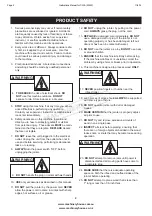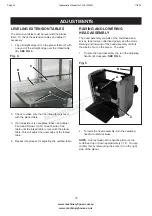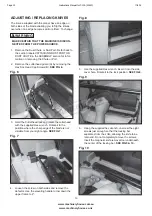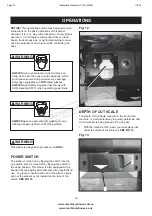
18
BASIC OPERATION
To avoid serious personal injury,
NEVER
stand directly
in line with the front or rear of the planer. If an object is
thrown from the planer, it will travel in this direction.
1. Stand to either the left or right side of the planer.
2. Flip the switch to the ON position.
3. Lift the workpiece onto the infeed table by grabbing
the edges of the board at the middle of the length.
NOTE:
For longer pieces, be sure to use additional
supports or stands
4. Push slightly on the board and allow the feed rollers
to pull the board through the planer. Once the feed
rollers start to pull the workpiece through, let go of
the board and allow the rollers to do their job.
DO
NOT
push or pull on the workpiece once the rollers
have engaged.
5. Move to one side of the rear of the planer and
receive the planed workpiece by grabbing the
edges of the wood, just like you did when feeding
the workpiece in.
6. It normally takes several passes of varying depths
to achieve a smooth finish, so repeat this process
as many times as necessary. Remember the less
you take off in a pass, the smoother the finish will
be.
THICKNESS PLANING
Thickness planing sizes the workpiece to a desired
thickness, while at the same time creating a smooth
and level surface. The thickness of each cut will
depend on the type of wood, width of the workpiece,
and condition of the workpiece (i.e. dryness, grain com-
position, straightness, etc). Always make thin test cuts
on a scrap piece of wood prior to performing cuts on
the workpiece.
WARNING
!
GENERAL TIPS AND GUIDELINES
Κ Thickness planing always works best when at least
one side of the workpiece has a flat surface. If both
sides of the workpiece are rough, feed one face of
the board over a jointer until the entire surface is flat
Κ
ALWAYS
plane both sides of the workpiece to reach
the desired thickness
DO NOT
plane workpieces less than 1/8-in thick, less
than 3/4-in wide, or shorter than 7-in long
Κ It is not recommended to use the planer at it’s maxi-
mum depth of cut (1/16”) and at it’s full width (13”).
Continuous use at the maximum settings will shorten
the life of the motor.
Κ Light cuts create a smoother finish than heavier cuts
Κ If a smooth cut is not obtained, try reversing the
board for proper grain orientation.
AVOIDING SNIPE
Snipe, gouging or depression of the board at the ends,
can occur when the board is not properly supported.
For workpieces longer than 4 ft, greater care must be
taken to reduce the problem because the additional
length of the workpiece translates into more unsup-
ported weight pulling down on the end of the board.
This unsupported weight will work against keeping the
stock flat. Make sure to use supports or stands when-
ever long pieces are being planed to avoid this prob-
lem. Since snipe occurs at the end of the boards, it is
good practice to start with a workpiece that is slightly
longer than what you need so that you can simply cut
www.machineryhouse.com.au
www.machineryhouse.co.nz
Page 19
Instructions Manual for T-13A (W813)
1
1/9/19












































